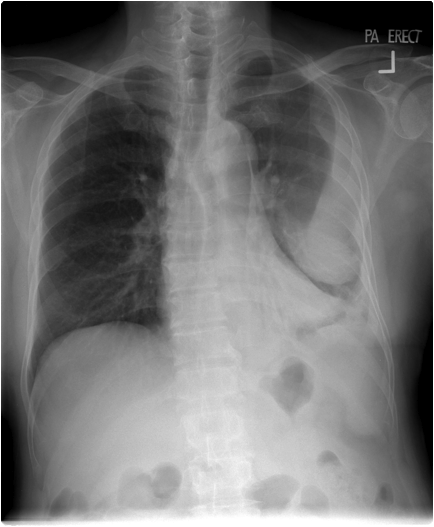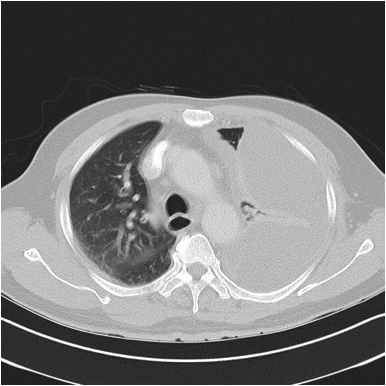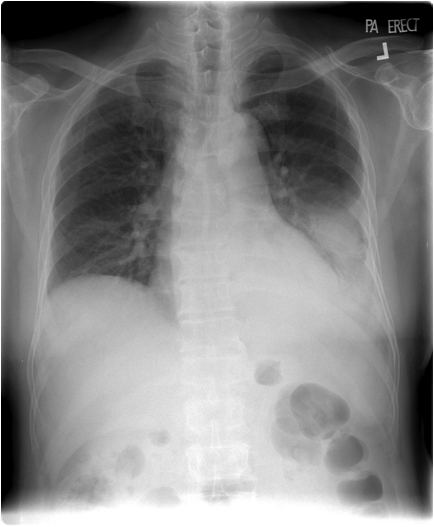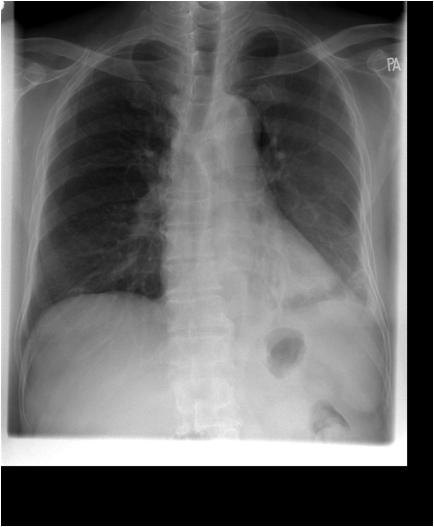Browse through our Journals...
Asymptomatic Endobronchial Fish bone causing collapse of lung lobes: A case report
Abstract:
Acute foreign body aspiration present itself as cough, wheezing and fever, however chronic foreign body aspiration can be asymptomatic yet can cause serious complications.
I report a case of asymptomatic fish bone aspiration with granulation tissue formation leading to collapse of lobes of lung in a 69 year old Chinese male with known history of Angiosarcoma.
Patient admitted in ward because of left flank pain and was found to have pyelonephritis on CT scan. Restaging CT Thorax for angiosarcoma showed focal stricture of left main bronchus, resulting in partial collapse of left upper lobe and near complete collapse of left lower lobe with no obvious obstructing mass. The collapsed segment showed lung abscess with parapneumonic loculated pleural effusion. Flexible bronchoscopy showed a foreign body but no mass. A 3 cm foreign body was removed with rigid bronchoscope likely fish bone. CXR showed improvement in consolidation and pleural effusion post foreign body removal with antibiotics.
Introduction
Tracheo bronchial foreign body aspiration is rare in adults, although incidence increases with age. Risk factors are depressed mental status due to neurological or psychiatric disorders or impairment in swallowing reflex, patient using oral prosthesis or under sedation .Most often these FB are found in right bronchial tree (75%) cases as right bronchus is more in line with trachea.
Case report
69 year old Chinese male diagnosed to have biopsy proven angiosarcoma of frontal scalp seven years back .He presented with plaques and lesion over forehead with on and off headache for two years. Patient was treated with single agent Ifosfamide in view of local disease and no systemic metastasis. However patient opted for radiation therapy after first cycle hence followed up with surgery and radiation therapy including photodynamic therapy. Patient had undergone removal of right necrotic frontal bone with application of split skin graft in Jan 2009.
Patient admitted under oncology in Nov 2009 for Left flank pain for one day duration and scrotal pain for three months. On examination he had frontal lesions healing well after grafting, there was decreased air entry in left lung, abdomen was soft, non tender and renal punch was negative. Scrotum had chronic excoriation,
Figure 1:- CXR showing lung changes on admission
Figure 2: CT Thorax showing Lung collapse secondary to foreign body
Figure 3A:- CXR post fish bone removal
Figure 3B:- CXR four months after removal of fish bone
Initial investigation shows infective picture with raised white cells15K and microcytic hypochromic anemia with hemoglobin of 6.1.Patient was considered for scopes in view of anemia and restaging CT scans were ordered.
CT chest showed a focal stricture in left main bronchus, with partial collapse of left upper lobe and complete collapse with no obvious cause of obstruction. There were several lung abscesses and large loculated left pleural effusion. CT abdomen showed infective hypo densities in bilateral kidneys.
Patient underwent flexible bronchoscopy that showed foreign body in bronchus straddling across opening of left upper division/ lower lobe.
Rigid bronchoscopy shows granulation tissue extending from left secondary carina to left lower lobe segments. A foreign body seen lodged in left lower lobe segments likely fish bone measuring 3 cm was removed.
BAL fluid was infective with LDH 1850 and glucose 3.1.Cultures did show Pseudomonas aeruginosa.
Patient was given intravenous antibiotics for lung abscesses and pleural effusion. There was improvement seen on repeated x-rays. He was asymptomatic throughout and did not give any history of aspiration.
An antral ulcer was seen in Oesophagoduodenoscopy and biopsy showed chronic atrophic gastritis to suggest cause of anemia.
Patient was discharged well with two weeks oral antibiotics.
Discussion
Foreign body aspiration:-. Endobronchial foreign bodies have been classified into three groups on basis of bronchoscopy findings[8]:
- FB without granulation tissue.
- FB in bronchial tree with marked granulation.
- FB embedded in granulation tissue.
Flexible bronchoscopy is both a diagnostic and therapeutic tool in managing foreign bodies in respiratory tree. Removal of foreign body is important to prevent long term sequel. Most common foreign bodies in adults are Fish and animal bones.
Fish bone complications:-
Fish bones have been known to cause many gastrointestinal complications. These can migrate in different areas and can cause complications including perforation of GI tract. The incidence of perforation can be as high as 1%. Various cases have been reported to cause esophageal, stomach, appendix, liver perforation due to fish bones. These may cause local or general peritonitis
Complications also include inflammatory conditions like cholecystitis, intraabdominal abscess secondary to fish bone ingestion[3,6]. Case has been reported in Taiwan in elderly 75 year old male for intraabdominal abscess secondary to fish bone with partial response to CT guided drainage and requiring surgical intervention.
Cases have been reported for rare but grave complications like fistula formation, aortoesophageal fistula and tracheoesophageal fistula has been known in the past[4]. Grave complications like aortic rupture are rare but have been seen.
Respiratory complications
Cases have been reported of fish bone aspiration leading to obstructive ventilatory changes that reversed with removal of bone with bronchoscope[5]. Pyopneumothorax has been reported in two cases secondary to fish bone penetration of esophagus[7].
Our case report provides a direct support for asymptomatic fish bone aspiration that has caused lung collapse and parapneumonic empyema.
.
Conclusion
Fish Bone aspiration can lead to lung collapse and obstructive pneumonia. It is not uncommon to find a patient who is unaware of aspiration however asymptomatic lung collapse is very rare. Patient shows improvement after removal of foreign bodies as occurred in our case.
References
Al-ABDUWANI, JA et al. 2010. Bimanual, intraoperative, fluoroscopy guided removal of nasopharangeal migratory fish bone from carotid space. Journal of Laryngology and Otology.2010
FURUKAWA, T. et al. 2008, A case of inflammatory granuloma secondary to foreign body (Cryptomeria) mimicking a bronchial tumor. Nihon Kokyunki Gakkai Zasshi 2008.46 (12) 987-91.
HORII, K. et al. 1999. Successful treatment of hepatic abscess that formed secondary to fish bone. Surgery Today. 29(9).
KELLY,S.L. et al. 2009. Successful management of an aortoesophageal fistula caused by fish bone. Journal of Cardiothoracic Surgery. Case Report
KIMURA, M. et al. 1992. A case of obstructive ventilator disturbances caused by bronchial wall granulation due to fish bone. Nihon Kokyunki Gakkai Zasshi. Case Report.
KUNIZAKI, M. et al. 2009. Cholecystitis caused by fish bone. American Journal of Surgery. Case Report
LIU, S.F. et al.1995.Pyopneumothorax associated with unsuspected endobronchial foreign body. Chang Geng Yi Xue Za Zhi 1995.18 (3) 292-6
.TAKEISHI, K.et al. 2008.Pulmonary granuloma possibly caused by Fish bone material. Kyobu Gekka. 2008, 61(13):1114-7
Copyright Priory Lodge Education Ltd 2010
First Published November 2010
Click
on these links to visit our Journals:
Psychiatry
On-Line
Dentistry On-Line | Vet
On-Line | Chest Medicine
On-Line
GP
On-Line | Pharmacy
On-Line | Anaesthesia
On-Line | Medicine
On-Line
Family Medical
Practice On-Line
Home • Journals • Search • Rules for Authors • Submit a Paper • Sponsor us
All pages in this site copyright ©Priory Lodge Education Ltd 1994-






